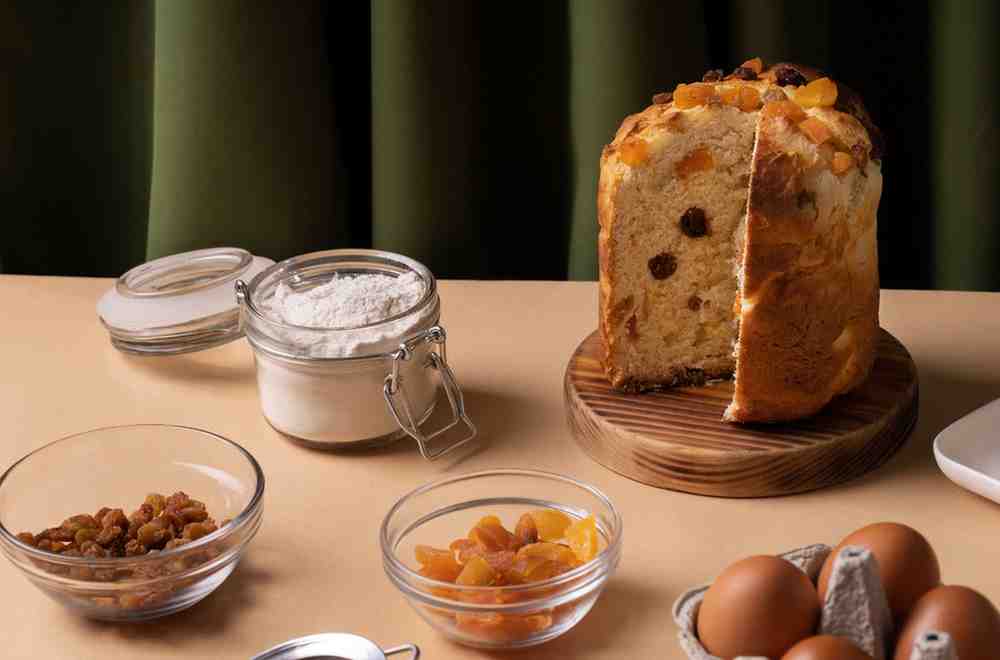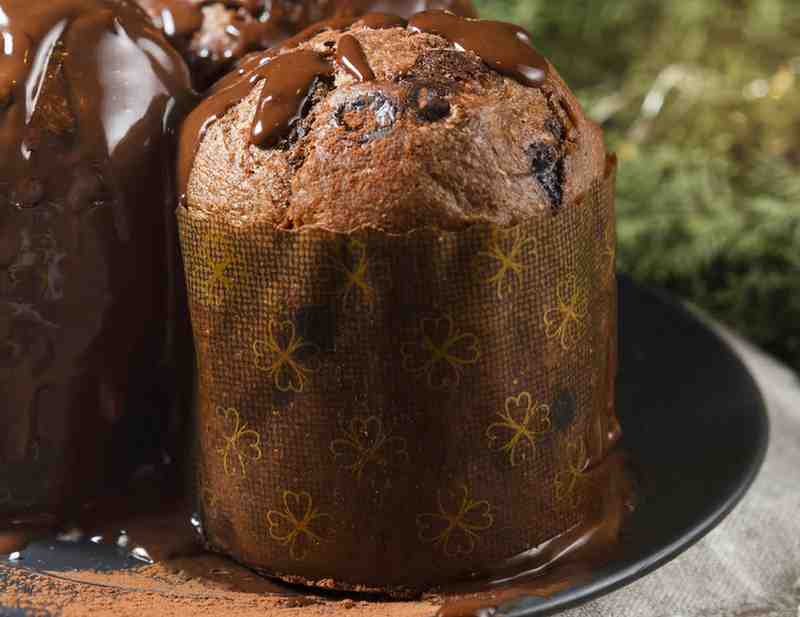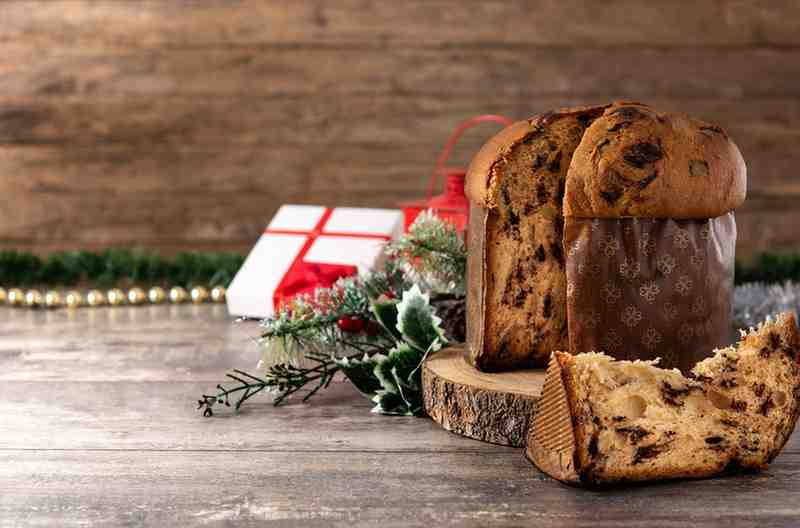Panettone, the quintessential Italian Christmas treat, is loved for its rich, buttery flavor, soft texture, and sweet fillings of dried fruits and citrus. However, the traditional version is packed with sugar and high-carb flour, making it a challenge for those following a keto diet. But don’t worry With a few clever ingredient swaps, keto enthusiasts can now enjoy a low-carb, sugar-free version of this holiday favorite without sacrificing flavor.
Ingredients and Their Keto Substitutes
To make a keto-friendly version of panettone, it’s essential to replace high-carb ingredients with keto-approved alternatives that retain the traditional texture and flavor. The result? A delicious, light panettone that’s perfect for low-carb diets.
Traditional Ingredients vs. Keto Substitutes
- Flour: Regular wheat flour is the foundation of traditional panettone, but it’s loaded with carbs. In keto baking, almond flour and coconut flour are excellent substitutes. Almond flour is rich in healthy fats and has a mildly nutty flavor, while coconut flour absorbs moisture and adds a natural sweetness.
- Sugar: Regular granulated sugar is out of the question for keto recipes. Instead, use erythritol or stevia as your sweeteners. Both are natural, low-carb alternatives that won’t spike your blood sugar levels.
- Dried Fruits: The sweet candied fruits in traditional panettone can be swapped for sugar-free dried fruits or omitted altogether. You can also add sugar-free chocolate chips as a fun, keto-friendly variation.
- Butter and Eggs: These remain essential in the keto version as they add richness and moisture, helping to create the signature soft and fluffy texture of panettone.
Special Keto Ingredients Breakdown
- Almond Flour: Almond flour is the backbone of keto baking. It’s low in carbs, high in fats, and provides the perfect texture for keto panettone, mimicking the structure of traditional wheat flour.
- Coconut Flour: Coconut flour is incredibly absorbent, so you only need a small amount. It helps balance the moisture in the dough and adds a delicate, sweet flavor.
- Erythritol: A popular keto-friendly sweetener, erythritol offers sweetness without the carbs or calories. It dissolves well and provides a similar sweetness level to sugar.
- Psyllium Husk: Psyllium husk powder helps create a dough-like structure in keto recipes. It adds bulk and mimics the elasticity gluten provides in traditional bread.

How to Make Keto Panettone
Making keto panettone requires patience and precision, but the result is a soft, flavorful bread that stays true to the original while being low in carbs. Here’s a step-by-step guide to help you bake the perfect keto panettone.
Step-by-Step Process
- Prepare the Yeast Mixture:
- Dissolve 1 teaspoon of active dry yeast in ¼ cup of warm water with 1 teaspoon of erythritol. Let it sit for 5-10 minutes until frothy. This step activates the yeast, which will help give your panettone a light, airy texture.
- Mix the Dry Ingredients:
- In a large bowl, combine 2 cups of almond flour, ¼ cup of coconut flour, 2 tablespoons of psyllium husk powder, and a pinch of salt. These dry ingredients will form the base of your keto dough, providing structure and bulk without the carbs.
- Blend the Wet Ingredients:
- In a separate bowl, beat 3 large eggs, ½ cup of melted butter, and 1 teaspoon of vanilla extract. The butter adds richness, while the eggs help bind the dough together and give it a soft texture.
- Combine Wet and Dry Ingredients:
- Slowly pour the wet mixture into the dry ingredients, stirring constantly to combine. Once the mixture forms a dough, knead it lightly until smooth. If the dough is too dry, add a splash of water or almond milk until it reaches the right consistency.
- Incorporate the Yeast:
- Gently fold in the activated yeast mixture, ensuring it’s evenly distributed throughout the dough. The yeast will help the dough rise, giving your keto panettone its signature light texture.
- Add Keto-Friendly Add-ins:
- Fold in ½ cup of sugar-free dried fruits, cranberries, or chocolate chips. These add-ins give the panettone its classic, festive look and flavor.
Kneading and Resting the Dough
Kneading is crucial for developing the right texture in your keto panettone. Even though keto dough lacks gluten, which gives traditional bread its elasticity, kneading still helps mix the ingredients and allows the dough to hold together during baking.
- Knead the Dough: Knead the dough for about 5 minutes on a lightly floured surface (use almond flour to avoid adding extra carbs). The dough should be smooth and elastic.
- Let the Dough Rest: Place the dough in a lightly greased bowl, cover it with a towel, and let it rest in a warm, draft-free spot for about 1-2 hours. While keto dough doesn’t rise as much as regular dough, the yeast will help it puff up slightly.
Shaping and Baking the Panettone
- Shape the Dough:
- Once the dough has rested, shape it into a round loaf. If you’re making smaller panettones, divide the dough into portions and place them in greased molds or deep paper baking cups.
- Second Rise:
- Allow the dough to rise again for about 30-60 minutes. This second rise ensures the panettone develops a light, airy texture.
- Bake the Panettone:
- Preheat your oven to 350°F (175°C). Bake the panettone for 40-50 minutes, or until the top is golden brown and a toothpick inserted in the center comes out clean. If the top browns too quickly, cover it with aluminum foil to prevent burning.
- Cool the Panettone:
- Once baked, let the panettone cool completely in its mold before slicing. Cooling is essential for setting the texture and preventing the bread from collapsing.
Common Mistakes and How to Avoid Them
- Dry Texture:
- If your keto panettone turns out too dry, it could be due to overbaking or not enough moisture in the dough. To prevent this, keep a close eye on baking time, and don’t be afraid to add a little extra butter or almond milk if the dough seems dry during mixing.
- Dense Bread:
- Keto bread can be denser than traditional bread due to the lack of gluten. Ensure that your yeast is active and give the dough enough time to rise. Kneading the dough properly will also help incorporate air, resulting in a lighter texture.
- Inconsistent Rising:
- Since keto dough doesn’t rise as much as traditional dough, it’s essential to give it a warm, draft-free environment for proofing. If the dough doesn’t rise, check that your yeast is fresh and that your water wasn’t too hot, which can kill the yeast.
Keto Panettone Variations
- Chocolate Chip Keto Panettone: Replace the dried fruits with sugar-free chocolate chips for a decadent twist on the traditional recipe.
- Mixed Berries Panettone: Add unsweetened dried cranberries or blueberries for a fruity, festive variation that’s still low-carb.

Nutritional Benefits of Keto Panettone
Keto panettone isn’t just a delicious holiday treat; it’s a smart choice for anyone following a low-carb or ketogenic diet. Traditional panettone, while delicious, is loaded with sugar, refined flour, and dried fruits that can quickly lead to high carb intake. A keto version replaces those carb-heavy ingredients with low-carb alternatives that still offer the rich flavors and soft texture panettone is known for. Let’s take a closer look at the nutritional benefits of keto panettone compared to its traditional counterpart.
Comparing Keto Panettone to Traditional Panettone
- Carbohydrates: The biggest difference between keto panettone and traditional panettone is the carbohydrate content. While regular panettone can contain up to 50 grams of carbs per slice (depending on the recipe and size), keto panettone dramatically reduces this, typically to under 10 grams of net carbs per slice.
- Sugar-Free Sweetness: Keto panettone uses sugar substitutes like erythritol or stevia, which don’t raise blood sugar levels. This makes keto panettone a great option for people managing diabetes or looking to avoid sugar spikes.
- Higher Fat Content: Since keto focuses on high-fat, low-carb eating, keto panettone is rich in healthy fats from ingredients like almond flour, butter, and coconut oil. These fats help keep you fuller longer and provide sustained energy throughout the day.
- Lower in Calories: While traditional panettone can be calorie-dense due to its high sugar and carbohydrate content, keto panettone is generally lower in calories per serving, making it a lighter option for those watching their caloric intake.
Macronutrient Breakdown of a Keto Panettone Slice
A typical slice of keto panettone (depending on recipe variations) offers the following macronutrient profile:
- Calories: Approximately 180-220 calories per slice
- Net Carbs: Around 5-8 grams of net carbs
- Fat: 15-20 grams of healthy fats
- Protein: 5-7 grams of protein
- Sugar: Less than 1 gram (thanks to sugar-free sweeteners)
By swapping out the carb-heavy ingredients, keto panettone provides a much healthier alternative without sacrificing taste.
Storing and Serving Keto Panettone
One of the benefits of panettone is that it stores well, allowing you to enjoy this festive bread over several days or even weeks. Proper storage techniques will ensure that your keto panettone stays fresh and flavorful.
Best Storage Practices
- Room Temperature: If you plan to consume the panettone within a few days, store it at room temperature. Wrap it tightly in plastic wrap or place it in an airtight container to prevent it from drying out. This will keep the panettone fresh for 3-5 days.
- Refrigeration: To extend its shelf life, store your panettone in the refrigerator. Wrap it in plastic wrap and place it in a sealed container to keep it fresh for up to a week. Before serving, warm it slightly in the oven to restore its soft texture.
- Freezing for Long-Term Storage: Keto panettone freezes exceptionally well. Once fully cooled, wrap it tightly in plastic wrap and then a layer of aluminum foil. Place it in a freezer-safe bag or container and store it in the freezer for up to 3 months. When ready to enjoy, thaw the panettone at room temperature or in the refrigerator overnight. For best results, reheat it in a low oven to restore its soft, fluffy texture.
Creative Serving Suggestions
Keto panettone is versatile and can be served in various ways beyond just slicing it straight from the loaf. Here are a few ideas to elevate your panettone experience:

- Toasted with Butter: Lightly toast slices of keto panettone and slather them with butter for a delicious breakfast or snack. The toasting enhances the flavors and adds a slight crunch to the soft bread.
- Keto Panettone French Toast: Turn leftover panettone into a luxurious keto-friendly French toast. Simply dip slices of panettone in an egg mixture with a splash of cream and cinnamon, then fry until golden. Serve with sugar-free syrup or a sprinkle of cinnamon.
- Keto Panettone Bread Pudding: For a comforting dessert, cube the panettone and layer it in a baking dish with an egg and cream mixture. Bake until golden brown, and enjoy with a drizzle of sugar-free caramel sauce or whipped cream.
- Pair with Coffee or Keto Hot Chocolate: Keto panettone pairs beautifully with a hot beverage, making it the perfect treat to enjoy with your morning coffee or a cozy cup of keto-friendly hot chocolate.
FAQs About Keto Panettone
When diving into the world of keto baking, questions often arise about ingredients, techniques, and storage. Here are some common questions people ask when preparing keto panettone.
What Makes Panettone Keto-Friendly?
Keto panettone is made keto-friendly by substituting high-carb ingredients like flour and sugar with low-carb alternatives. Almond flour and coconut flour replace wheat flour, while erythritol or stevia are used instead of sugar. These swaps dramatically reduce the carb content, making the bread suitable for those following a ketogenic diet.
Can You Make Keto Panettone Without Almond Flour?
Yes, you can make keto panettone without almond flour. If you have a nut allergy or simply prefer a different texture, coconut flour or a low-carb flour blend can be used instead. Keep in mind that coconut flour absorbs more liquid than almond flour, so you’ll need to adjust the liquid ratio in your recipe accordingly. You may also want to include additional binding agents like psyllium husk to maintain structure.
How Long Does Keto Panettone Last?
Keto panettone can last several days when stored correctly. Once baked and cooled, wrap the panettone in plastic wrap and store it at room temperature for up to 5 days. For longer storage, you can refrigerate it for up to 1 week, although it’s best served fresh.
What’s the Difference Between Keto and Gluten-Free Panettone?
Keto and gluten-free panettone share some similarities but are not exactly the same. Both avoid traditional wheat flour, making them gluten-free. However, keto panettone focuses on reducing carbs and increasing healthy fats, while gluten-free versions may still contain higher amounts of carbohydrates if they use gluten-free flours like rice or tapioca flour.
Can You Use Artificial Sweeteners in Keto Panettone?
Yes, you can use artificial sweeteners in keto panettone. However, it’s best to stick to natural keto-friendly sweeteners like erythritol, monk fruit sweetener, or stevia. Avoid sweeteners like aspartame or saccharin, as they can have unwanted aftertastes or may not bake well.

